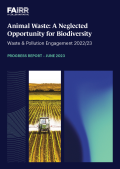Report Overview
Biodiversity loss is now widely recognised by policymakers, businesses, investors, and other stakeholders as among the major challenges confronting the planet and its inhabitants. The 2023 edition of the World Economic Forum’s Global Risks Report identified it as “one of the fastest-deteriorating global risks over the next decade”, warning: “Over the next 10 years the interplay between biodiversity loss, pollution, natural resource consumption, climate change and socioeconomic drivers will make for a dangerous mix.”
With the array of biodiversity-related metrics continuing to grow, numerous dedicated tools can be used to help investors identify which sectors and/or companies are most dependent on ecosystem services. In turn, they can also provide a range of data-driven insights into how a sector/company impacts biodiversity. In this report, FAIRR combined materiality data from ENCORE with Corporate Biodiversity Footprint data from Iceberg Data Lab and indicators from the Coller FAIRR Protein Producer Index to generate targeted, data-supported insights on ways to interpret these datasets to assess companies’ exposure to biodiversity, and their response to these risks and opportunities.
FAIRR’s analysis of biodiversity footprints and risk management focuses on a sample of six companies included in the Coller FAIRR Protein Producer Index 2023/24 (the Index 2023/24), across segments within the meat and dairy sector. We aggregated key performance indicators (KPIs) from the nature related factors within the Index and analysed them through the lens of five pillars of biodiversity loss as identified by the Intergovernmental Science-Policy Platform on Biodiversity and Ecosystem Services (IPBES): Land & sea-use change, direct exploitation of natural resources, climate change, pollution, and invasive alien species.
Report Highlights
In depth case studies for six protein producers, dissecting:
Which parts of their business models can raise their corporate biodiversity footprints based on ENCORE and Iceberg Data Lab
The quality of their response to these challenges compared to best practice, based on the findings of the Coller FAIRR Protein Producer Index 2023/24 related to the five key drivers of biodiversity loss identified by the IPBES
Ideas for engagement based on this data and analysis.
As well as:
Discussion of selected biodiversity frameworks and standards
Discussion of selected biodiversity metrics, including a deep-dive on corporate biodiversity footprints
Analysis of impacts and dependencies of beef and dairy, large-scale feed crops on biodiversity using UNEP’s ENCORE tool
Analysis of corporate biodiversity footprint data using Iceberg Data Lab’s Mean Species Abundance data




